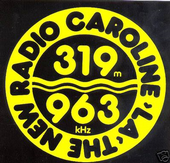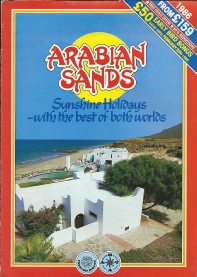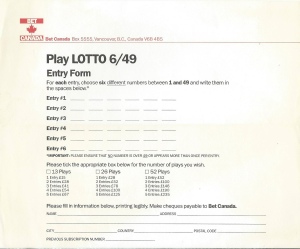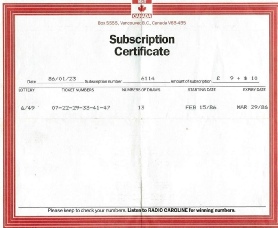© 2014-


Radio Caroline 1980s - History (3)
After a day and a half of test transmissions official broadcasts for Radio Caroline started at 12 noon on 20th August 1983. The station had a new format concept - music content would take precedence over the spoken word, with two or usually three tracks being played consecutively without any interruption for DJ announcements or commercials. However, over the next few days this format was gradually watered down as various DJs began to inject more and more speech content into their programmes.
music content would take precedence over the spoken word, with two or usually three tracks being played consecutively without any interruption for DJ announcements or commercials. However, over the next few days this format was gradually watered down as various DJs began to inject more and more speech content into their programmes.
Initially Radio Caroline's broadcasting hours were from 7.00am -
The station gave out a mailing address in Los Angeles, which was the office of DJ Wolfman Jack's agent, Dan Kelly. Although it was not a particularly convenient arrangement to have a mailing address 6,000 miles away from the station the system obviously worked because within three weeks of Radio Caroline's transmissions starting the first listeners' letters were being read on air by the DJs. Plans were announced in early September 1983 for the station to also open an office in Monte Carlo to handle more day-
Radio Caroline's return in August 1983 caused an immediate confrontation with the British authorities. The frequency of 963kHz used by the offshore station had already been allocated by the Department of Trade to the organisers of a Christian Pop Festival at Knebworth Park, Hertfordshire at which pop star and evangelist Cliff Richard was billed to appear the following weekend. Although at that time Radio Caroline was only using about 17Kw of the possible 50Kw available from its transmitter, the Department of Trade was forced to allocate the pop festival another frequency to ensure that there were no complaints of interference by the event's organisers.
A similar problem also affected about twenty campus radio stations at colleges and universities throughout central and southern England, again forcing the authorities to allocate new frequencies before the start of term in September and October. Despite this reallocation by the authorities formal protests about Radio Caroline's transmissions were received from University Radio Nottingham, and similar student stations at Colchester, Sussex, Hull, Southampton and Bath.
universities throughout central and southern England, again forcing the authorities to allocate new frequencies before the start of term in September and October. Despite this reallocation by the authorities formal protests about Radio Caroline's transmissions were received from University Radio Nottingham, and similar student stations at Colchester, Sussex, Hull, Southampton and Bath.
Some disappointment was expressed by listeners at the format and overall sound of the new Radio Caroline. The general explanation offered for the change from the previous Top 40 format was that the station was now directed at a new audience -
Throughout September and October 1983 Radio Caroline's broadcasts steadily built up a large audience. A Gallup Poll survey, published at the end of October 1983, showed that in the UK an average of 7% of the adult population (around 4 million people) had listened to the station in its first few weeks on the air. Another survey in Holland at about the same time showed that half a million people listened regularly to the station while another half a million claimed to tune in occasionally. Encouraged by these significant audience figures and the success of its Album Rock Format, Radio Caroline extended its broadcasting to 24 hours a day from 12th November 1983.
Unsurprisingly the authorities were not happy about the re-
1984
The Ross Revenge survived many storms in the North Sea at the end of 1983 and the beginning of 1984, but the elements finally won on 20th January 1984. The radio ship lost her anchor, drifted onto a sandbank and Radio Caroline's transmissions were stopped at 9.20pm because the ship had started to list dangerously. However, the following day the Ross Revenge was able to free herself from the sandbank and sail under her own power to a position in international waters about five miles from the Sunk Head Lightship. Broadcasts recommenced after a temporary anchor had been dropped and within a few days a replacement anchor was acquired and delivered to the Ross Revenge, enabling her to return to the normal position.
It was extremely important that Radio Caroline had returned to the air as quickly as possible in January 1984 because the first paid commercials were due to be broadcast during that week. Radio Caroline had survived since its return in August 1983 on the promotion of records from UK and international record companies and up to the end of 1983 a consortium of Canadian businessmen had also been financing the station. However this 'subsidy' had been reduced at the end of the year and the sudden loss of revenue caused many problems including the non-
One of the early adverti sers on Radio Caroline was the Canadian National Lottery -
sers on Radio Caroline was the Canadian National Lottery -
Entrants were required to select 6 out of 49 numbers to win a possible jackpot prize, hence the trade name Lotto 6/49. In 1986 the Canadian Lottery was estimated to sell $2 billion worth of tickets, producing revenue of $740 million for the national and provincial governments to spend on community, sports and cultural organisations.
A number of organisations, not directly connected with the Canadian Lottery, set up operations to sell tickets abroad, a practice which was not illegal under Canadian law, hence the promotion of Lotto 6/49 over the airwaves of Radio Caroline (and later Radio Monique) via a company called Bet Canada (registered in British Colombia as International Betcan Ltd.). 
The Dutch authorities soon put pressure on the Canadians to withdraw the Lotto 6/49 commercials from Radio Monique fearing that this would have a detrimental effect on their own state lottery, but the promotion continued via Radio Caroline and provided much needed financial income for that station.
The arrival and initial huge success of another offshore station -
Radio Caroline started test transmissions on 594kHz (505m) on 12th July 1984 and from 27th July programmes were broadcast for a few days simultaneously on this frequency as well as 963kHz (319m). The announced purpose of dual frequency transmissions was to improve the station's signal into central London, which it did during the day, but not during the hours of darkness. Consequently on 5th August 1984 the station moved to 576kHz (521m), which successfully provided an improvement in night time reception.
Throughout the autumn of 1984 Radio Caroline continued to broadcast the same programmes 24 hours a day on both frequencies, but in the early hours of 11th December 1984 a split service was started between 2.00am and 6.00am each morning under the individual call signs Caroline 576 and Caroline International (on 963kHz). Nevertheless it soon became public knowledge that the dual frequency programming was in preparation for the launch of another new offshore radio station -


Click on picture to enlarge

Daily Mail
16th August 1983

The Guardian
16th August 1984
Re-

Arabian Sands



Promo to attract advertisers to Radio Caroline, 1984

Lotto 649




Daily Telegraph
18th August 1983
Radio Caroline News intro 1983


History
Key Dates
Ship and Location
Technical
Staff
Programmes





Treasure Chest

Lotto 649 Entry Form
Courtesy Ray Clark
Click to enlarge
Lotto 649 Subscription Certificate
Courtesy Ray Clark
Click to enlarge
Arabian Sands brochure
Courtesy Ray Clark
Click to enlarge




Back to Britain Gallery


Back to Radio Caroline 1980s
